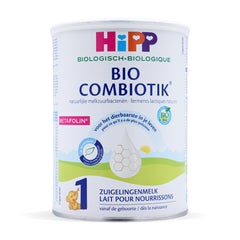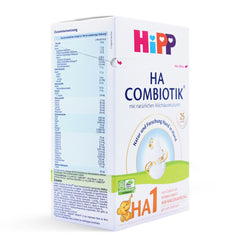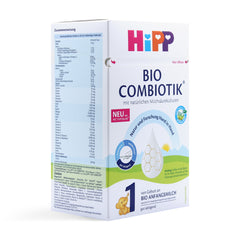Comparing HiPP and Similac Formulas
62 hours of research 5 minute read

Breast milk remains widely recognized as the gold standard for infant nutrition. However, breastfeeding may not always be possible due to various reasons. In such cases, HiPP baby formula and Similac formula are two prominent options parents consider when choosing an alternative for their little ones. With the organic movement gaining momentum, HiPP organic baby formula has become a popular selection for parents seeking a natural and high-quality choice. This comprehensive guide will delve into a detailed comparison of HiPP and Similac, exploring their ingredients, manufacturing practices, and environmental impact to empower parents to make informed decisions regarding their baby's HiPP Organic formula, HiPP formula stage 1, HiPP HA formula (HiPP hypoallergenic formula), HiPP Anti Reflux formula, HiPP comfort formula, HiPP Bio Combiotik, HiPP Stage 2, and Similac baby formula, Similac sensitive formula, Similac Advance formula, Similac Neosure formula (Similac infant formula), Similac Total Comfort formula, Similac 360 Total Care infant formula, and Similac toddler formula.
Before diving into specifics, understanding the distinctions between American and European organic certifications is crucial. The United States Department of Agriculture (USDA) oversees organic certification within the US, while the European Union (EU) governs organic standards in Europe. HiPP analysis reveals that it adheres to stricter European organic regulations, which often emphasize factors like animal pasture access and limitations on synthetic additives. This distinction sets the stage for evaluating the organic credentials of HiPP and Similac formulas.
American Organic VS European Organic
Growing hormones and genetically modified organisms are not present in either Similac or HiPP infant formula, as they are in all organic milk. They all claim to use a special combination of vitamins and minerals as well as organic lactose as a basis. It's interesting to note that while these elements appear to be relatively comparable at first glance, there are important distinctions between American and European organic standards when examining the laws.
American Organic Certification Policies for all United States organic and non-organic baby formulas are set by the United States Department of Agriculture (USDA) under the Food and Drug Administration (FDA). In the U.S., the USDA allows producers to use a “Certified Organic” label if the product meets the following standards:
Growing organic crops using synthetic pesticides, fertilizers, or sewage sludge is not possible. Radiation or genetic engineering is not permitted for organic crops. Animals are not allowed to be treated with synthetic hormones or antibiotics, and they must only consume organically grown feed (free of animal byproducts). All animals must have access to the outside world, especially ruminants, or animals with hooves, like cows. One cannot clone an animal. Similar to most FDA regulations, the ambiguous criteria permit a lesser standard. The American baby formula firms are allowed to have their interpretation of the law, and they frequently make decisions that are better for their bottom line than for your child's nutrition.
In the absence of clear norms, we observe obvious infractions of what would be deemed organic standards, such as the absence of a minimum daily requirement for the duration of an animal's access to pasture time. The animal will satisfy the USDA criterion even if it just moves from barn to barn until it reaches a small area. Furthermore, the FDA does not distinguish between baby formula labeled as "pasture-raised" and "pasture-fed," nor does it provide information to consumers regarding the possibility that the formula may have spent months or even only a few minutes in the pasture.
For certified organic foods, the USDA does publish a list of approved pesticides and fertilizers. However, the list is not as strict as it could be if environmental advocates developed it, as industry lobbyists have contributed to the recommendations for what should be allowed and what shouldn't.
However, under the FDA's ambiguously worded regulations, it is also perfectly acceptable to grow organic crops next to non-organic ones, meaning that anything sprayed on the non-organic crop may wind up on American baby formula labeled as "certified organic." Farmers frequently refer to this practice as "overspray" and it occurs frequently.
The FDA guidelines also place restrictions on additional components, although they do not bar the use of lab-created preservatives and nutrients in organic baby food.
Due to evidence of both immediate and long-term health effects, several compounds are prohibited from baby nourishment in Europe:

The producers of European baby formula adhere to holistic, environmentally beneficial organic farming practices, with strict regulations that allow for only strict interpretation.
European agricultural procedures consider all facets of animal health and husbandry, from soil to manufacture, using a holistic approach free of hormones, steroids, or preventive antibiotics.
Crucially, European infant formulae go through a number of safeguards to guarantee that cross-contamination won't happen at any stage of the procurement process and that all organic criteria are respected.
The long-term social and economic aspects of farming, as well as the communities these family-owned enterprises live in and support, are covered by European Union guidelines.

When comparing the specifics of US and EU organic rules, there are disparities.
Notable Differences Between HiPP and Similac
| Comparison Factors | HiPP Formula | Similac Formula |
|---|---|---|
| Brand Reputation | Organic, sustainable farming practices, positive endorsements from parents and professionals. | Established brand, endorsed by healthcare professionals. |
| Nutritional Composition | Skimmed milk, lactose, and organic vegetable oils (including palm). Some contain maltodextrin or starch. | Nonfat milk, many contain Corn Syrup Solids or table sugars. Most contain Soy oil. |
| Probiotics and Prebiotics | Contains prebiotics (GOS and FOS) and probiotics (Lactobacillus fermentum and Bifidobacterium infantis). | Most formulas contain only prebiotics (FOS). |
| Cost and Availability | Higher cost, imported from Europe, available online | Lower cost, produced domestically in the US, available at major retailers and pharmacies. |
| Formula Alternatives | Holle, Kendamil, Lebenswert, Nannycare, Aptamil, Kabrita. | Enfamil, Gerber, Happy Baby |
Ingredient Summary:
Examining the ingredients is an essential first step in evaluating formulas for babies. Here is a thorough analysis of the main components included in the formulations for Similac and HiPP:
| Ingredient | HiPP | Similac |
|---|---|---|
| Protein Source | Organic whey and casein | Skimmed milk and whey prote |
| Fat Source | Organic vegetable oils | Vegetable oils |
| Carbohydrates | Organic lactose | Corn syrup, high fructose corn syrup (varies by formula) |
| DHA and ARA | Naturally sourced | Processed using hexane solvents |
| Palm Oil | Organic Palm Oil | Used |
| Preservatives | None | May contain preservatives |
Similarities and Differences:
While HiPP and Similac share commonalities in offering formulas for different nutritional stages, being GMO-free, and adhering to quality control measures, significant differences emerge in their organic standards compliance, environmental impact, and ingredient composition. HiPP stands out for its commitment to stricter European organic regulations, avoidance of environmentally harmful ingredients like palm oil, and the inclusion of natural prebiotics and probiotics to support a healthy gut microbiome in your baby.
| Aspect | HiPP | Similac |
|---|---|---|
| Nutritional Stages | Offers a range of formulas for different stages of baby’s development. | Offers a range of formulas for different stages of baby’s development. |
| GMO-Free Claims | Advertises that its formulas are free of genetically modified organisms (GMOs). | Advertises that its formulas are free of genetically modified organisms (GMOs). |
| Quality Control | Adheres to quality control procedures and safety standards. | Adheres to quality control procedures and safety standards. |
| Organic Standards | Follows stricter European organic standards. | Adheres to American organic standards. |
| Environmental Impact | Uses organic palm oil. | Uses palm oil in its formulas. |
| Prebiotics and Probiotics | Includes natural prebiotics and probiotics to promote a healthy gut microbiome. | May include prebiotics but typically does not include probiotics. |
| Carbohydrate Sources | Primarily uses organic lactose as the carbohydrate source. | May use corn syrup or other sweeteners as carbohydrate sources. |
Similarities
- Nutritional Stages: Both HiPP and Similac offer a range of formulas designed for different stages of your baby's development.
- GMO-Free Claims: Both brands advertise that their formulas are free of genetically modified organisms (GMOs).
- Quality Control: Both adhere to quality control procedures and safety standards.
Differences
- Organic Standards: HiPP follows stricter European organic standards, while Similac adheres to American organic standards.
- Environmental Impact: HiPP avoids palm oil, which can be environmentally destructive, while Similac uses it.
- Prebiotics and Probiotics: HiPP includes natural prebiotics and probiotics to promote a healthy gut microbiome.
- Carbohydrate Sources: HiPP primarily uses organic lactose, while Similac may use corn syrup or other sweeteners.
HiPP and Similac Comparison Chart
| HiPP Vs Similac | Age | Certified Organic | No GMOs | No Antibiotics | No Growth Hormones | Non- Fat | Skim Milk | Prebiotics | Probiotics | Whey | Starch/Maltodextrin | Sugar (not lactose-based) | Soy/ Soy Oil | Palm Oil |
|---|---|---|---|---|---|---|---|---|---|---|---|---|---|---|
| HiPP Dutch Combiotik | ||||||||||||||
| Stage 1 | 0-6 months | ✅ | ✅ | ✅ | ✅ | ❌ | ✅ | ✅ | ✅ | ✅ | ❌ | ❌ | ❌ | ✅ |
| Stage 2 | 6-12 months | ✅ | ✅ | ✅ | ✅ | ❌ | ✅ | ✅ | ✅ | ✅ | ❌ | ❌ | ❌ | ✅ |
| Stage 3 | 1 year + | ✅ | ✅ | ✅ | ✅ | ❌ | ✅ | ✅ | ✅ | ✅ | ❌ | ❌ | ❌ | ✅ |
| HiPP German Combiotik | ||||||||||||||
| Stage Pre | 0-6 months | ✅ | ✅ | ✅ | ✅ | ❌ | ✅ | ✅ | ✅ | ✅ | ❌ | ❌ | ❌ | ✅ |
| Stage 1 | 0-6 months | ✅ | ✅ | ✅ | ✅ | ❌ | ✅ | ✅ | ✅ | ✅ | ❌ | ❌ | ❌ | ✅ |
| Stage 2 | 6-12 months | ✅ | ✅ | ✅ | ✅ | ❌ | ✅ | ✅ | ✅ | ✅ | ❌ | ❌ | ❌ | ✅ |
| Stage 2 No Starch | 6-12 months | ✅ | ✅ | ✅ | ✅ | ❌ | ✅ | ✅ | ✅ | ✅ | ❌ | ❌ | ❌ | ✅ |
| Stage 3 | 1 year + | ✅ | ✅ | ✅ | ✅ | ❌ | ✅ | ✅ | ✅ | ✅ | ✅ | ❌ | ❌ | ✅ |
| HiPP Toddler Formula | ||||||||||||||
| HiPP Kindermilch 1+ | 1 year + | ✅ | ✅ | ✅ | ✅ | ❌ | ✅ | ✅ | ✅ | ❌ | ❌ | ❌ | ❌ | ✅ |
| HiPP Kindermich 2+ | 2 year + | ✅ | ✅ | ✅ | ✅ | ❌ | ✅ | ❌ | ❌ | ❌ | ❌ | ❌ | ❌ | ✅ |
| HiPP Specilaty Formulas | ||||||||||||||
| HiPP HA Stage Pre | 0-6 months | ❌ | ✅ | ✅ | ✅ | ❌ | ✅ | ❌ | ✅ | ❌ | ❌ | ❌ | ❌ | ✅ |
| HiPP HA Stage 1 | 0-6 months | ❌ | ✅ | ✅ | ✅ | ❌ | ✅ | ✅ | ✅ | ❌ | ❌ | ❌ | ❌ | ✅ |
| HiPP HA Stage 2 | 6-12 months | ❌ | ✅ | ✅ | ✅ | ❌ | ✅ | ✅ | ✅ | ❌ | ❌ | ❌ | ❌ | ✅ |
| HiPP AR | 0+ | ❌ | ✅ | ✅ | ✅ | ❌ | ✅ | ✅ | ✅ | ❌ | ❌ | ❌ | ❌ | ✅ |
| HIPP Comfort | 0+ | ❌ | ✅ | ✅ | ✅ | ❌ | ✅ | ✅ | ✅ | ✅ | ✅ | ✅ | ❌ | ✅ |
| Similac Organic | ||||||||||||||
| Similac with Iron | 0-12m | ❌ | ❌ | ✅ | ✅ | ✅ | ❌ | ❌ | ❌ | ❌ | ❌ | ❌ | ✅ | ❌ |
| Similac A2 milk | 0-12m | ❌ | ❌ | ✅ | ✅ | ✅ | ❌ | ❌ | ❌ | ❌ | ❌ | ❌ | ✅ | ❌ |
| Similac Non-Organic | ||||||||||||||
| Pro-Advanced | 0-12m | ❌ | ❌ | ❌ | ✅ | ✅ | ❌ | ❌ | ❌ | ✅ | ❌ | ❌ | ✅ | ❌ |
| Pro-Sensitive | 0-12m | ❌ | ❌ | ❌ | ✅ | ❌ | ❌ | ❌ | ❌ | ❌ | ✅ | ✅ | ✅ | ❌ |
| Pro-Total Comfort | 0-12m | ❌ | ❌ | ❌ | ✅ | ❌ | ❌ | ❌ | ❌ | ✅ | ✅ | ✅ | ✅ | ❌ |
| For Spit-up (Easy to Digest) | 0-12m | ❌ | ❌ | ❌ | ✅ | ✅ | ❌ | ❌ | ❌ | ✅ | ❌ | ❌ | ✅ | ❌ |
| Advanced with Iron | 0-12m | ❌ | ❌ | ❌ | ✅ | ❌ | ❌ | ❌ | ❌ | ❌ | ✅ | ✅ | ✅ | ❌ |
| Senstive | 0-12m | ❌ | ❌ | ❌ | ✅ | ❌ | ❌ | ❌ | ❌ | ❌ | ✅ | ✅ | ✅ | ❌ |
| Alimentum (Hypoallergenic) | 0-12m | ❌ | ❌ | ❌ | ✅ | ❌ | ❌ | ❌ | ❌ | ❌ | ❌ | ✅ | ✅ | ❌ |
| Soy Isomil (Hypoallergenic) | 0-12m | ❌ | ❌ | ❌ | ❌ | ❌ | ❌ | ✅ | ❌ | ❌ | ❌ | ✅ | ✅ | ❌ |
| Neosure | 0-12m | ❌ | ❌ | ❌ | ✅ | ✅ | ❌ | ❌ | ❌ | ✅ | ❌ | ✅ | ✅ | ❌ |
| Lamehadrin | 0-12m | ❌ | ❌ | ✅ | ✅ | ✅ | ❌ | ❌ | ❌ | ✅ | ❌ | ✅ | ❌ | ❌ |
| Supplementation Gentle | 0-12m | ❌ | ❌ | ✅ | ✅ | ✅ | ❌ | ✅ | ❌ | ✅ | ❌ | ❌ | ✅ | ❌ |
| Pure Bliss | 0-12m | ❌ | ❌ | ✅ | ✅ | ✅ | ❌ | ❌ | ❌ | ✅ | ❌ | ❌ | ✅ | ❌ |
| Similac Toddler Formulas | ||||||||||||||
| Toddler with A2 Milk | 1-3 yrs | ✅ | ❌ | ❌ | ✅ | ✅ | ❌ | ❌ | ❌ | ❌ | ❌ | ❌ | ✅ | ❌ |
| Go & Grow | 1-3 yrs | ❌ | ❌ | ❌ | ✅ | ✅ | ❌ | ❌ | ❌ | ❌ | ❌ | ❌ | ✅ | ❌ |
| Go & Grow Sensitive | 1-3 yrs | ❌ | ❌ | ❌ | ✅ | ✅ | ❌ | ❌ | ❌ | ❌ | ❌ | ✅ | ✅ | ❌ |
| Go & Grow Sensitive Milk -based | 1-3 yrs | ❌ | ❌ | ❌ | ❌ | ❌ | ❌ | ❌ | ❌ | ✅ | ❌ | ❌ | ✅ | ❌ |
| Pure Bliss Toddler Drink | 1-3 yrs | ❌ | ✅ | ✅ | ✅ | ✅ | ❌ | ❌ | ❌ | ❌ | ❌ | ❌ | ✅ | ❌ |
What Makes HiPP Stand Out?
Several factors distinguish HiPP as a potentially superior choice compared to Similac:
- Organic Composition: HiPP formulas are crafted with organically sourced vitamins, minerals, and 100% organic lactose, aiming to ensure the highest quality and purity.
- Avoidance of Unwanted Ingredients: HiPP prioritizes the exclusion of additives, soy, and preservatives commonly found in conventional formulas, promoting a potentially cleaner and potentially healthier product for your baby.
- European Quality Standards: HiPP's adherence to stricter European organic standards reflects a potential commitment to upholding rigorous manufacturing practices and environmental sustainability.
- Environmental Consciousness: By avoiding palm oil, a controversial ingredient due to its potential negative environmental impact, HiPP demonstrates a potential dedication to eco-friendly production methods.
Top Formulas and Where to Buy:
For parents considering HiPP or Similac formulas, here are some top recommendations:
Top HiPP Formulas:
Top HiPP Specialty Formulas
Top HiPP Goat Formulas
- HiPP Goat
- HiPP Dutch Goat
Top Similac Formulas
- Similac® 360 Total Care®
- Similac® Pro-Advance®
- Similac® Advance®
| Category | Formula | Description |
|---|---|---|
| Top HiPP Formulas | HiPP Combiotic Dutch Formula | Combines prebiotics (GOS) and probiotics to support a healthy gut flora and immune system. |
| HiPP Combiotic German Formula | Includes natural lactic acid cultures, Omega-3 and Omega-6 fatty acids for brain and eye development. | |
| HiPP UK Formula | Contains prebiotics and probiotics, essential fatty acids, and vitamins for overall growth and development. | |
| Top HiPP Specialty Formulas | HiPP Comfort | Addresses colic, constipation, and gas with reduced lactose and partially hydrolyzed whey proteins. |
| HiPP AR (Anti-Reflux) | Reduces reflux and spit-up with natural locust bean gum to thicken the formula. | |
| HiPP HA (Hypoallergenic) | Uses extensively hydrolyzed proteins to reduce allergenic potential for infants at risk of allergies. | |
| HiPP Dutch HA | Hypoallergenic formula with extensively hydrolyzed proteins, prebiotics, and probiotics for digestive health. | |
| Top HiPP Goat Formulas | HiPP Goat | Made with organic goat milk, suitable for infants with cow milk protein sensitivity, providing easy-to-digest proteins. |
| HiPP Dutch Goat | A Dutch-made formula with organic goat milk, offering a gentle and digestible alternative for sensitive tummies. | |
| Top Similac Formulas | Similac® 360 Total Care® | Contains prebiotics, nucleotides, and DHA for comprehensive nutrition and immune support. |
| Similac® Pro-Advance® | Features 2'-FL HMO for immune support, DHA, and Lutein for brain and eye development. | |
| Similac® Advance® | Offers complete nutrition with essential vitamins, minerals, and nutrients to support growth and development. |
For those interested in purchasing HiPP formulas, Organic Life Start offers a convenient online platform with various discounts and subscription options.
Stretch Your Savings with Organic Life Start
For parents who choose HiPP formulas, Organic Life Start can be a budget-friendly option. They offer several ways to save on your baby's essential nutrition:
- Bulk Discounts: Purchase the largest size pack of your chosen HiPP formula and save up to 15% off the regular price. Remember, the exact discount may vary depending on the specific formula you select.
- Subscription Savings: Sign up for recurring deliveries of your HiPP formula through Organic Life Start's subscription service and enjoy an additional 5% off each order. This ensures a consistent supply while saving you time and money.
By combining these discounts, you can potentially achieve significant savings on HiPP formulas for your baby. Visit the Organic Life Start website to explore the full selection of HiPP formulas and take advantage of these valuable offers!
HiPP vs. Similac
While both HiPP and Similac can be viable alternatives to breastfeeding, the former may be a superior choice for parents seeking organic, environmentally conscious, and potentially nutritionally superior infant formulas. However, consulting with a pediatrician is always recommended to select the most suitable formula based on your individual baby's needs and preferences.
Most Popular HiPP Formulas
Organic Life Start is committed to providing accurate, reliable, and trustworthy information to parents and caregivers. We carefully choose credible sources and follow a meticulous fact-checking process to uphold the highest standards in infant nutrition and parenting advice. To learn more about our dedication to accuracy, please explore our editorial guidelines.
Link To Sources











Mychal Kearns -
Similac and HiPP are both popular infant formulas, but they differ in quality and ingredients. Similac is widely available in the U.S. and often uses corn syrup solids and palm oil. HiPP, on the other hand, is made in Europe and follows strict EU organic standards. It avoids unnecessary additives and focuses on gentle, natural ingredients. HiPP formulas often include prebiotics and probiotics for digestion support. They are designed to be closer to breast milk in composition and taste. Our family values clean, organic nutrition for our baby. That is why we find HiPP to be a safer and healthier choice. I recommend HiPP because it gives us confidence in what we are feeding our child.
Camron Heaton -
When we first tried Similac, it was easy to find locally, but our baby had some gas and spit-up that made us look for alternatives. Switching to HiPP felt different right away since it’s lighter on the stomach and uses lactose instead of corn syrup solids. I also liked that HiPP’s European standards limit additives that sometimes show up in U.S. formulas. It’s not just about nutrition on paper — it really came down to how calm and comfortable our baby seemed after each feed.
Shante P -
I had no idea that the contrast between HiPP’s EFSA-regulated organic formulations and Similac’s FDA-compliant, science-based approach could significantly influence a baby’s digestive comfort, immune support, and even environmental sustainability! I discovered that HiPP uses extensively hydrolyzed proteins, probiotics, and eco-friendly practices under tight EU standards, which may help reduce allergenicity and support gentle digestion. In contrast, Similac offers a broader range of specialized options—like Sensitive, Alimentum, and Advance—with added nutrients such as DHA, lutein, and prebiotics (OptiGRO™), though under looser U.S. regulatory protocols. I was surprised to learn that Similac’s spectrum of formulas means greater accessibility and tailored choices, but HiPP stands out for its rigorous ingredient purity and organic integrity. I hadn’t considered how these regulatory and ingredient differences could directly affect a baby’s immune support, sleep, digestion, and overall gut health. It’s eye-opening to realize that beyond brand name and price, hidden factors like sourcing standards and nutrient design can play a huge role in a little one’s well-being. This comparison has definitely reshaped how I view premium versus widely available baby formulas.